back to pictures 56 - 59
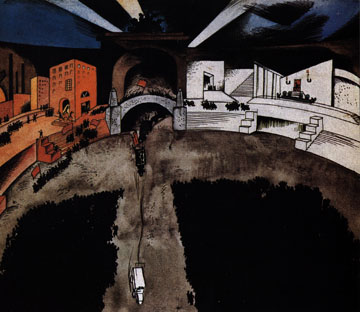 #60
#60
In 1920, Iuri Annenkov (1889-1974) designed a massive production to
commemorate the third anniversary of the Bolshevik coup of 1917. "The Storming of the
Winter Palace" was directed by the famous theatrical professional Nikolai Evreinov and was
subtitled a "mass action." This indeed it was, as the list of actors required for the right side
of the "stage" (the production took place outdoors on the steps of and square adjacent to
the former Tsarist palace in which the provisional government officers were meeting when
the Bolshevik takeover occurred): 125 ballet dancers, 100 circus people, 1,750
supernumeraries and students, 200 women, preferably students, 260 secondary actors, and
150 assistants. Props included flags, tanks, armored cars, etc. Spectacles such as these
were not merely designed to commemorate Soviet power. They were meant to usher in a
new kind of theater, one in which the distinction between actor and spectator was broken
down.
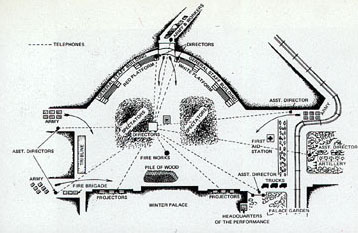 #61
#61
Another design for this same "mass action."
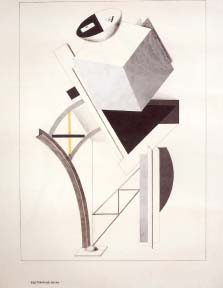 #62
#62
In 1920-21 El Lissitsky produced a series of drawings of costume and
theatrical designs for "Victory Over the Sun". How such drawings could have been useful
for actual costumes is not clear, but this was never a problem as they were never used.
Still, it is interesting to compare Lissitsky's drawings with those produced by Malevich for
the original production in 1913 (#s 53-55a). Such a comparison points up the differences
between the more architecturally and engineeringly-oriented constructivist school, and
Malevich's more painterly concept of suprematism. This drawing shows a Futurist
Strongman.
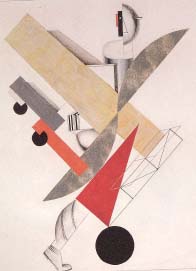 #63
#63
The Time Traveler from Lissitsky's drawings for "Victory Over the Sun".
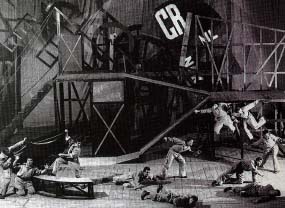 #64
#64
In 1922, Meyerhold staged his first Constructivist performance. This
was of "The Magnanimous Cuckold" by the Belgian playwright Fernand Crommelynk.
Popova's three-dimensional, bare-wood set stood alone on an otherwise bare stage. Note
the windmill blades in the upper right of the construction, which were meant to remind the
audience of the play's Flemish origins. The actors in this photograph are carefully placed,
and they worked together in a remarkably rhythmic production.
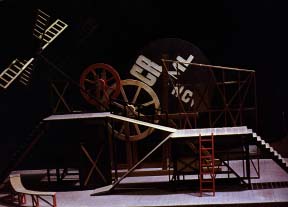 #65
#65
This photograph shows Liubov Popova's maquette for the construction
used in Meyerholdıs 1922 production of "The Magnanimous Cuckold".
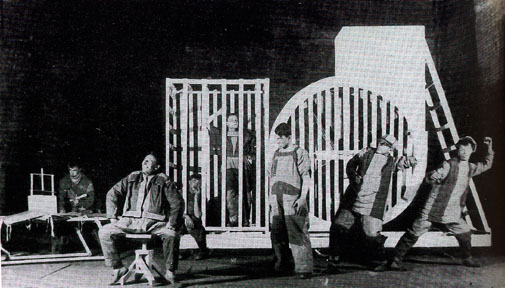 #66
#66
For Meyerhold's 1922 production of "The Death of Tarelkin", he
engaged the constructivist artist and designer Varvara Stepanova. As opposed to the single
machine that had dominated the stage in Popova's design for "The Magnificent Cuckold"
(performed earlier in the same year, see illustrations #64, 65), Stepanova created a series of
discrete "apparatuses" that could be combined to make larger constructions or used
separately. The apparatuses could be and were manipulated in a variety of ways by
Meyerhold's skilled actors. The production as a whole fit in well with Meyerhold's desire
at this time to bring circus and acrobatic element into the serious theater.
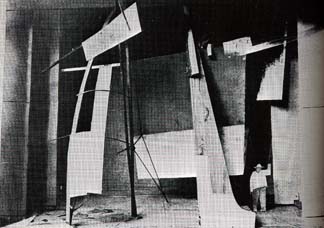 #67
#67
In 1923, Vladimir Tatlin designed, directed, and starred in a
performance of Velimir Khlebnikov's play "Zangezi" that was presented by an amateur
troupe at the Museum of Artistic Culture in Petrograd. Khlebnikov had died earlier in the
year, and the performance was to be a memorial to Tatlin's favorite poet. To Khlebnikov's
construction of words, where sound was the principle building element, Tatlin attempted to
find a counterpart in tangible construction, built with a variety of materials in different
surfaces and shapes. According to the artist's conception, certain combinations of colors
and forms corresponded to certain sounds; light and costumes also played an important
role in the production. This photograph shows Tatlin's maquette for the basic stage design.
Note the ways in which Tatlin's set grows out of his purely sculptural concerns in his relief
of 1916 (#20).
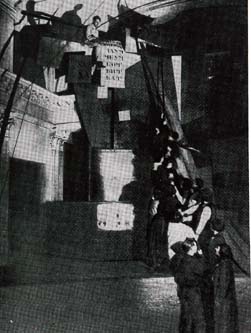 #68
#68
This photograph was taken during one of the performances. At the very
top of the picture you can see Tatlin in the role of Zangezi.
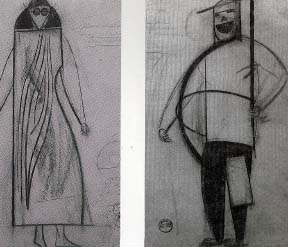 #69
#69
Sketches for costume designs for the figures of "Woe" and "Laughter"
from the final scene of Khlebnikov's "Zangezi" as designed by Tatlin in 1923.
 #60
#60
 #61
#61
 #62
#62
 #63
#63
 #64
#64
 #65
#65
 #66
#66
 #67
#67
 #68
#68
 #69
#69